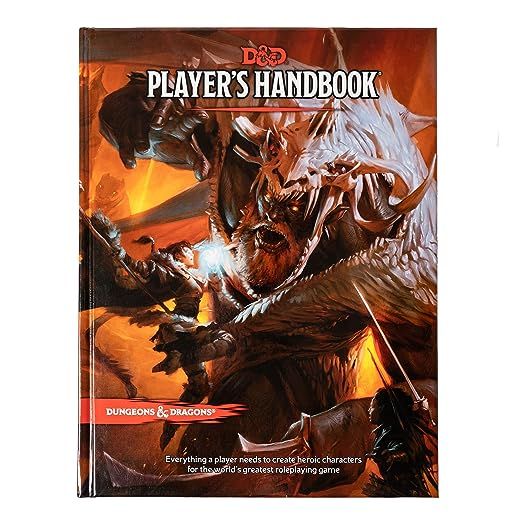D&D Player’s Handbook (Dungeons & Dragons Core Rulebook)
4.9
-
53,294 ratings
- The essential rulebook for Dungeons & Dragons (5th edition)
- Contains all the rules you need to know to play D&D
- Step-by-step guide to creating and leveling up characters
- Go-to player reference for over 350 spells, equipment, and more
- 1 of 3 D&D Core Rulebooks—the Player’s Handbook (rules for playing the game), the Dungeon Master’s Guide (how to run the game), and Monster Manual (creatures to encounter in your game)
Hardcover
$35.49
Ships from
Amazon.com
Payment
Secure transaction
ASIN
0786965606
Print length
0 pages
Language
English
Publisher
Wizards of the Coast
Publication date
September 08, 2014
Dimensions
8.55 x 0.79 x 11.14 inches
Item weight
1 pounds
About the authors
Dungeons & Dragons
Dungeons & Dragons (D&D) is a tabletop role-playing game (RPG) where players create characters and explore fantasy worlds together. The game involves players forming an adventuring party, battling enemies, finding treasure, and leveling up in experience. The Dungeon Master (DM) acts as the game's referee and storyteller, creating the characters and locations, and maintaining the game's setting.
Read more
Reviews
Customer reviews
4.9 out of 5
53,294 global ratings

Jason N. Beil
5
Useful Set of Rules in an Attractive Package: D&D Is Back!
Reviewed in the United States on September 2, 2014
Verified Purchase
Dungeons and Dragons, the granddaddy of all role-playing games, has finally released its long-awaited fifth edition. The new rule set provides the perfect opportunity for lapsed players to return to the game, as well as allowing new players to get in on the ground floor. The new edition takes a back-to-basics approach, returning to an old-school feel while maintaining the best game mechanics from the last few editions. The rules have been streamlined without being over-simplified, making the game more inviting than ever for new players of all ages.
And new, preferably young, players are needed if the hobby is to survive into the future. Tabletop RPGs have always been a niche market, and while D&D enjoyed a brief period of mainstream popularity, it has had a difficult time competing for the attentions of the youth market. Video games, television, and movies have largely replaced board games, books, and table-top RPGs as their primary sources of entertainment. But if any edition of D&D has a chance to recapture some of that market, it is this one.
The new Player's Handbook, the first of three core rulebooks for the new D&D, is an exceptional product. It provides an excellent introduction to playing the game, with simple, clear rules for adventuring and combat. It provides details for the major player character classes and subclasses, along with all their abilities as they advance from levels one to twenty. All the classic classes and races are represented, as well as a few of the newer ones from third and fourth edition.
The writing is top-notch, with a lot of flavor and description provided on top of the necessary crunch of the rules. Far from a dry listing of rules and tables, the books is actually enjoyable to read. The artwork is fabulous, and its diversity should be applauded. Characters are male and female, black and white, and all the fantasy races are well represented. As others have pointed out, there are no gratuitous pictures of female warriors in scanty attire; all characters here are appropriately dressed for adventuring, not the boudoir! It is as if Wizards of the Coast has finally realized that D&D has a very diverse audience: male, female, black, white, Asian, gay, straight, and all permutations thereof. Instead of catering to one group, they have made an effort to be inclusive, and that can only be a good thing.
New in this edition are "backgrounds," which is a profession you practiced or life you led before you started adventuring. From criminal to noble, soldier to acolyte, these backgrounds provide additional skills, proficiencies, and role-playing hooks to help you get into character. Along with your class and race, your background rounds out your character into a life-like persona.
Races include your standard human, dwarf, elf, and Halfling, along with more exotic choices such as gnome, dragonborn, and tiefling. Classes are the classic fighter, wizard, rogue, and cleric, joined by the druid, sorcerer, bard, warlock, and more. Each class has two or more sub-classes (archetypes) which allow you further customize your character. Further, an optional feat system and the ability to multi-class can provide players with everything they need to make their character unique.
A great many spells are included in the book, and many of the classes have at least some spell-casting ability. Cantrips, or zero-level spells that can be cast at-will, provide wizards and sorcerers with useful powers they can use any time, so they won't find themselves relegated to throwing daggers once their sleep spells and magic missiles are exhausted for the day.
Combat is greatly simplified and will move much faster than it did in fourth edition, or even third. Gone are the slew of modifiers players and Dungeon Masters were forced to keep track of in previous editions, replaced by the Advantage and Disadvantage mechanic (roll 2d20, take the highest roll if you have Advantage on an attack, save, or ability check; roll 2d20 and take the lowest roll if you have Disadvantage). It is elegant, easy, and in practice, fast and fun. Using a grid and miniatures is optional, and combat in the imagination, called Theater of the Mind, is completely viable. Many players and Dungeon Masters will still prefer to use a grid to keep track of position, but it is not required since combat is not as tactical as it has been in the past. Or rather, it can be, but that is completely up to each individual group.
The rules are simplified, and intentionally left open to interpretation in places. This is because fifth edition is returning power to the Dungeon Master, or referee, as was the intention in 1974 when the game was created. Adding optional modular rules from the Dungeon Masters Guide and other sources should be simple with this system, as should creating house-rules. Each game will be different, and, depending on the skill of the referee, fast, deep, exciting, and unique. Role-playing and exploration are emphasized as much as combat (the Three Pillars of Adventure), and there are plenty of rules and suggestions in each category.
Physically, the book is beautiful and well put together. There have been some reports of faulty products, with pages missing, faded, or falling out, but my copy is pristine, as I am sure most are. If you purchase the book and receive a faulty copy, return it for a good one!
In all, the new Player's Handbook is a great product, and a must for the serious D&D player, or those wanting to give the game a try. The rule system is the best yet, and the book itself is a beautiful addition to any bookshelf. I am more than pleased with it, and highly recommend it to any role-playing game enthusiast.
Read more
16 people found this helpful
Amazon Customer
5
I pretty much ignored 3
Reviewed in the United States on November 30, 2015
Verified Purchase
I started playing D&D 28 yrs ago as a player in 1st ed. I then went on to run several long campaigns in 2nd ed, including through the "Players Options" period towards the end. I pretty much ignored 3.0, and took some time off. 3.5 got me fired up and I ran 2 more long campaigns with those rules, one of which I continue to run currently. Never touched 4th. I've been ignoring 5th, and Pathfinder for that matter, because I'm so heavily invested in my current campaign and I don't just drop things and start over because "newer, cooler" stuff comes out.
3.5 really began bothering me once my group hit 9th level or so. I still considered myself new to it, I had never played high levels in it, and I held out with 2nd ed. for so long I totally missed 3.0, and frankly, by the time I started playing 3.5 it was very old. So I really didn't know what to expect from 3.5 and it takes me a couple years to really grasp all the pros and cons of a system, and also to understand the way it's rules subtly effect the way people play, and the actual flavor of the game. Going into it, I was excited about 3.5. They appeared to both streamline and unify things with the d20 core mechanic. I liked what they did with the classes. I likes the artwork, and I thought the indepth skill system and the idea behind feats were both really cool..in theory...
In play, as both player and DM there was this feeling of being held back, and it was hard to pin down, and it just got worse the longer I played. 3.5 was difficult to run if you honor the rules and like to do things legit like I do. Don't get me wrong, winging it is a time honered tradition and an artform I love, but I also enjoy keeping to the rules in a way that feels both realistic and fun for everyone. I believe the very rules of the game themselves can be a inspiration for stories, themes, and ideas, for both players and dms.
Anyways, I'll stop now because this is not supposed to be a review of 3.5.
Got the 5th ed PHB. I was blown away. This reminded me of something that had almost died, a deep desire to imagine and play, it reminded me why I love this game so much, and it really brought me back to the kind of game I want to be playing. Here are the highlights 5th ed has added or changed:
-First, I applaud the writers. 3.5 edition books were tedious to read. The rules read like text from a technical manual. The fluff was either cliche, or trying so hard to be different that it came across again as, cliche. This entire book is just interesting and inspiring to read. I literally get adventure ideas from every other paragraph, it's just easy enough that you could hand it to your little brother and he could struggle through it, yet rich enough, deep enough, intelligent enough that you don't feel lame reading it as an adult.
-The have made your character's background actually important. For instance, if you're fighter was a criminal, he might be really good a sneaking around in addition to beating people up, but it he grew up in a temple, he might be versed on religious studies, as so fourth. Each character picks a background which gives them a few skills and a lot of flavor. There's more to it, but it's nice this game has finally brought character background into the mix in a formal way, instead of being just this thing you "should come up with", that a lot of people ignore, or gloss over. Where you came from now effects your character, and at the same time gives you another layer of customization without complicating things too much.
-Combat is less herky-jerky. They've somehow simplified things without taking away variety. In fact, in a couple sessions I played, it just felt like you could get more done with your round. They've also added in reactions, so different classes have the opportunity to interrupt the flow of the round and sneak something in that can change the battle or save the day. People have a lot more reason to pay attention when it's not their turn, because they may have a chance to act.
-They changed the way spells work in a way that nearly brought tears to my eyes...so much simpler, much more flexible, and still all the variety there was before in spells.
All in all I can't put this book down and can't wait to start a new group. 5th edition appears to really empower the DM, without taking away options from the players. I don't know if this makes sense to anyone, but the direction 5th is taking feels more like a fantasy game, and less like a superhero game. It feels a bit like 2nd edition, but still keeps the d20 core mechanic, and makes tangible, rather brilliant improvements on many areas of the game. I have to applaud WOtC, for doing this right beyond what I thought was possible. I didn't know if the spirit of the game could be recaptured after 3.5 and from what I've heard, 4th ed, turned it into an escalating numbers game that felt like WOW on paper. The rules add to the story now, instead of burdening it. The rules make combat exciting now instead of slowing it down. Magic feels magical again instead of being a handful of dice doing fire damage. D&D is back, it had regained its soul. If you've been out of the game for years because it just stopped feeling right to you, if you miss the game, if you're playing Pathfinder/3.5 but you're tired of the cold war/numbers escalations between you and your DM, and especially if you're tired of battles taking 3+hours, and being mentally exhausted because of the constant need to track so many numbers, if you're a gamer and you're curious about the godfather of all games, you should really check this out. There is so much content and flavor in this book. I paid $30 for it but would have been just as excited to pay more for it...it's just the best thing I've seen in some time.
Read more
23 people found this helpful
B. Mills
5
Doesn't replace 3.5 but provides streamlined rules for different kind of play (or players)
Reviewed in the United States on August 29, 2014
Verified Purchase
I play 3.5 and love/hate it. Mostly I love it but sometimes the rules get me frustrated when all I want to do is role-play and I need like 3 skills, a feat, and I have to make like 3 checks just to jump over a table (before anybody posts, this is an exaggeration - but my DM would force me to make at least a jump and balance check).
BUT, all the rules, and books, and home-brew stuff (and pathfinder) are also great. There is a rule for everything, even some that make no sense, but hey, there's a rule for that. And yet 3.5 remains incredibly flexible, and breakable, but then the DM rolls out broken monsters and its great. Never really played 2nd or 1st edition but some people really like em'. 3.5 didn't replace them and 5th edition didn't replace 3.5.
3.5 is still out there and will continue to be played and remains a very easy system to adapt and modify.
But 3.5 isn't always easy system to play, and 5th is. And that's a good thing.
Because 5th edition DOES replace 4th IMHO. If you are going to make the game easier to play, don't focus on combat, which 4th edition did. But 5th edition focuses on role-play, the whole point of DND for me personally. Role-play and play freedom, let me explain.
5th edition IS streamlined (major overhaul, skills pretty much gone - A/C is super simple - no more 5 foot steps, modifiers are much reduced) and it has game mechanics that promote role-play and even tables for rolling traits, bonds, and even flaws (personality, not physical) such as, "if there is a plan you forget or ignore it." Do you have to follow this? No, but if you do you gain inspiration points that give you advantage on a roll. Basically you get to roll 2 dice. The math on rolling two dice is a lot simpler than, mod here, ranks this, plus misc. mod this equals... Now it boils down to, 2 is better than one. All of this serves to make the game a lot more approachable to new players, but not by trying to sell them on combat (like 4e did) which will never work because none of us play the game for combat (or at least no one I know).
If you want streamlined combat well... video games are making millions (maybe billions?) of dollars a year for a reason.
But why does tabletop gaming have it all over video games though? Freedom to do ANYTHING. 3.5 gave us one kind of freedom (I can't speak of 2nd edition or anything earlier) by giving us a huge amount of rules and options to draw from that if you were willing to commit yourself to learning, provided literally limitless options. COmbat was fun in this context because you came up with some bizare cross-class with certain feats and items that allowed you to do something unique and interesting and power (sometimes totally broken).
5th edition gives us a different kind of freedom with much simplified rules that are more intuitive. All checks match to an ability (even saves) proficiency makes it much more intuitive for the lay person too. You want to jump over that table? Roll 1d20, plus dex modifier (obviously). Are you proficient, add 2, done. One roll, make it? Cool. It's also easier on the DM. I would feel comfortable DMing 5th edition and I am trying to talk my friends into trying it out with me because I think they could handle the system and would enjoy knowing what the hell they were doing. I have been selling my friends on table-top rpgs for years on the basis that "you can do literally anything" but I have done a lot of the math for them. Now I think they could handle their own characters stats. Also,I think the role-play rules will be great for my friends who are reluctant to come out of their shells right away.
It's not always about breaking the game, and WOTC has clearly tried to unbreakable a lot of things and put rational floors and ceilings (and reduce min-maxing). Yes, it feels more limited in this fashion, but it sucks in 3.5 when one player has an A/C of 31 and everyone else in the party has an A/C around 20. 5th edition reduces this possibility by reducing possibilities, but that opens up the world to your imagination over thinking only in terms of game mechanics. This is good for people who don't want to spend hours thinking about character creation and just want to play and not be told, sorry, you can't climb that because you don't have ranks in climb.
I know that pathfinder addressed some of these issues but that is still more "hardcore" that 5th edition IMHO.
And that's a good thing! If you don't have friends that you would like to game with who aren't into all the rules or are intimidated by RPGs, or you have never thought to yourself, man I just want to jump in and play instead of looking-up specifics half the time, then ignore this reivew (and this edition).
If you are perfectly happy with 3.5 and/or pathfinder, awesome. It's not going anywhere. I know I will keep playing both.
But 5th edition is a happy addition to my shelf (where 4th was not) because it offers a different way to play the game, and a system that is very good in my opinion; the care, and play-testing really shows!
Are there problems? Yes, the dragon-born draconic bloodline sorcerer thing is weird... Also dragonborn seem a little broken to me compared to other races, although all the races have received some love. I really enjoy the specifics of forest versus rock gnomes, hill dwarves versus mountain dwarves, and the flavor text is great!
Do I need the book to give me little blurbs on dwarf racial characteristics, what they are like, how they treat other races? No. But it's fun, and immersive. Do I need the book to give me sub-race characteristics? No, I could (or the DM could) do that on my/her own right. Could I streamline 3.5 rules? Yes, but I would probably spend a lot of time getting the kinks out. I've tried actually. But hey, do I eve need any book at all? I could just make up all the rules! I could completely invent my own game! And I bet it wouldn't be half as good as this one.
And in terms of what you pay for, it's great to get a flavor text, and a pretty complete system (I could DM a game right out of the PHB, there are even monsters in the back!) and the art!
The art is truly the best I have seen! I love to flip through the older books for the art, I am dorky like that. And 3.5 has some good art, and some is, OK. Pathfidner had a great art style IMHO. But the art in this edition raises the bar! and it is well integrated onto each highly readable page. I would like to note that I appreciate the lack of chain-mail bikinis. Once again, I am trying to get MORE of my friends to play, not fewer. The art would attract many and offend few. Which is a good thing.
So, in terms of what you pay for, good system, good layout, immersive flavor text and play ideas, and amazing art across every page. And it's complete enough you could DM right out of the PHB. At 50 bucks it's a good deal, at 30 its a steal!
But best of all, 3.5 still exists! But this edition makes the tabletop gaming library more versatile and appealing. IF you think that's a good thing, and want to try a new take on a great game, I highly recommend this edition (for what it is - which isn't 3.75).
If your happy with what your playing. Then happy gaming!
Read more
22 people found this helpful
Similar Books

Normal People: A Novel
4.1
-
123,460
$0.99
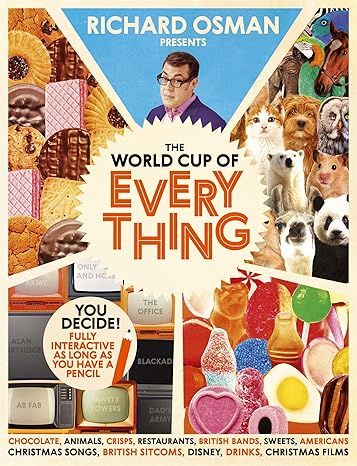
The World Cup Of Everything: Bringing the fun home
4.5
-
714
$1.99

The Primal Hunter 9: A LitRPG Adventure
4.8
-
5,987
$19.99

Margo's Got Money Troubles: A Novel
4.2
-
1,732
$14.99

He Who Fights with Monsters: A LitRPG Adventure
4.7
-
16,875
$16.47
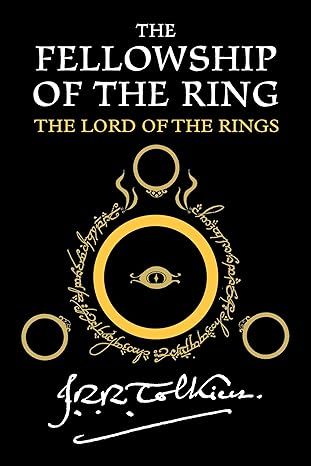
The Fellowship Of The Ring: Being the First Part of The Lord of the Rings (The Lord of the Rings, 1)
4.8
-
22,514
$12.08
Best sellers
View all
The Tuscan Child
4.2
-
100,022
$8.39
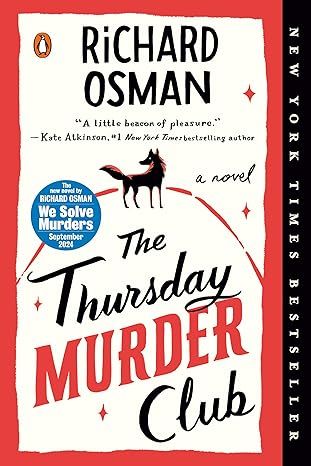
The Thursday Murder Club: A Novel (A Thursday Murder Club Mystery)
4.3
-
155,575
$6.33

Sapiens: A Brief History of Humankind
4.6
-
140,302
$13.49

The Butterfly Garden (The Collector, 1)
4.3
-
88,556
$9.59
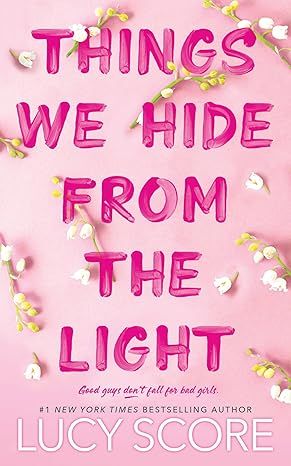
Things We Hide from the Light (Knockemout Series, 2)
4.4
-
94,890
$11.66
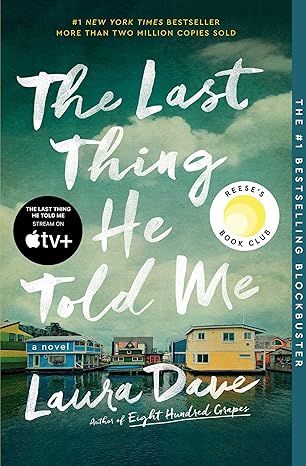
The Last Thing He Told Me: A Novel
4.3
-
154,085
$2.99
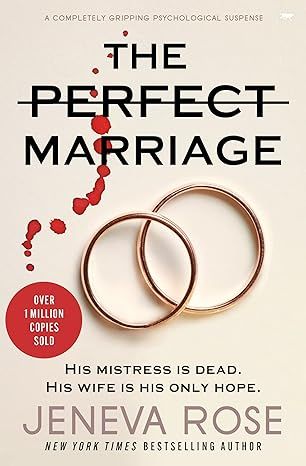
The Perfect Marriage: A Completely Gripping Psychological Suspense
4.3
-
143,196
$9.47

The Coworker
4.1
-
80,003
$13.48

First Lie Wins: A Novel (Random House Large Print)
4.3
-
54,062
$14.99

Mile High (Windy City Series Book 1)
4.4
-
59,745
$16.19

Layla
4.2
-
107,613
$8.99

The Locked Door
4.4
-
94,673
$8.53
